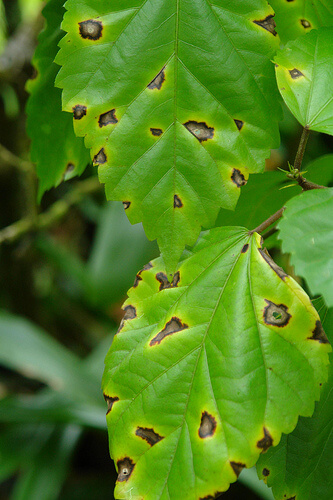
There are many threats when it comes to protecting your ornamental trees from diseases in the Atlanta area. Early detection is critical in keeping the disease from spreading before it has a chance to worsen. Some of these diseases can even migrate to nearby trees, weakening and even killing them. If you know what signs to look for or how to prevent them from the start, you’ll have a much better chance of saving your ornamentals from the devastation of these common Atlanta tree diseases.
- Powdery Mildew arrives in the form of a grayish dust that coats the trees and ultimately changes into a white mildew that can slow the growth or kill parts of the tree. This disease usually appears when it’s hot and humid outside, towards the end of spring or early summer. This disease attacks many popular Atlanta trees like crepe myrtles and dogwoods. If left untreated, it can also spread to other nearby plants, such as shrubs. While there are organic fungicides available, they’re not always very effective. The best approach to prevent the disease is by building up the health of your soil through best practices like organic fertilizers and soil amendments.
- Leaf Spot includes a variety of diseases that create spots on tree leaves. Typically, the spots are the result of a fungus but bacteria can also create leaf spot. If you suspect leaf spot, check for insects to rule them out as the cause of the spots first. Leaf spot doesn’t cause much damage to the trees, except in appearance only. This disease may cause some leaf loss, but established plants may not experience this. There are organic spray treatments available that can help treat leaf spot, but healthy soil and good air circulation are your best bet for controlling this disease.
- Sooty Mold can take over most any tree and is common on Camelias in the Atlanta area. It looks just like its name insinuates, a black soot that covers the leaves. Its mold spores are transferred by wind so it can spread easily to nearby trees. Sooty mold appears on trees that have aphids or scale insects. In order to get rid of the mold, you must first get rid of its food source: aphids and scales. These pests can be removed by wiping down the leaves with water or by spraying organic pesticides. Afterwards, a few rinses with the hose will get rid of the black soot. Continued control of aphids and scale insects will keep sooty mold at bay. Use dormant oil treatments or attract beneficial bugs that are natural predators to these pests.
If you’re unsure whether your trees are diseased or experiencing stress, an organic tree care regimen can be hugely effective in maintaining the health of your ornamentals. Our program includes applications of organic fertilizers, soil amendments and dormant oils that serve as natural disease and insect control preventatives. The goal to disease prevention is to promote beneficial bacteria and fungi in the soil with an organic ornamental care program that will keep your trees strong and healthy even in the peak season of insects and disease.

